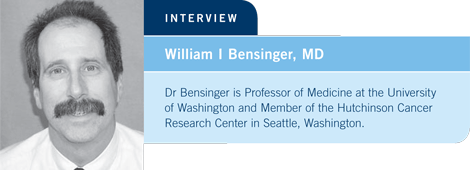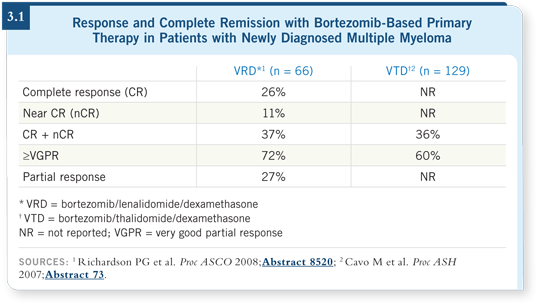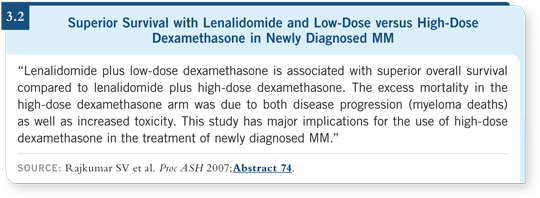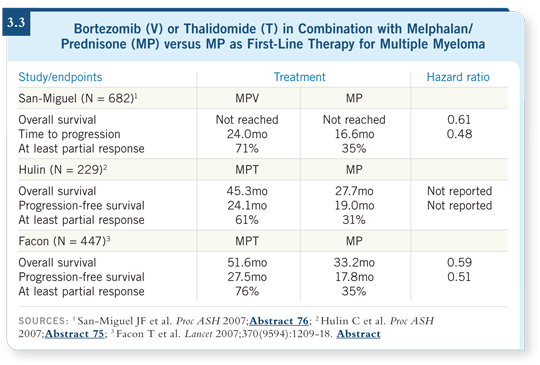

| Tracks 1-17 | ||||||||||||||||||||||||||||||||||||
|
Select Excerpts from the Interview
Track 5
![]() DR LOVE: Can you discuss the recent research reports on using novel
biologics in the up-front setting in multiple myeloma?
DR LOVE: Can you discuss the recent research reports on using novel
biologics in the up-front setting in multiple myeloma?
![]() DR BENSINGER: We have three novel combinations that have been studied to
a limited degree in randomized trials: thalidomide and dexamethasone (TD), bortezomib and dexamethasone (VD) and lenalidomide and dexamethasone
(RD). In addition, some early data exist with a triplet regimen combining
VTD (bortezomib, thalidomide and dexamethasone; [Wang 2005]), and we
have limited data on VRD (bortezomib, lenalidomide and dexamethasone;
[Richardson 2007]).
DR BENSINGER: We have three novel combinations that have been studied to
a limited degree in randomized trials: thalidomide and dexamethasone (TD), bortezomib and dexamethasone (VD) and lenalidomide and dexamethasone
(RD). In addition, some early data exist with a triplet regimen combining
VTD (bortezomib, thalidomide and dexamethasone; [Wang 2005]), and we
have limited data on VRD (bortezomib, lenalidomide and dexamethasone;
[Richardson 2007]).
For many years, the combination of vincristine, doxorubicin and dexamethasone (VAD) has been the standard for patients undergoing transplant, but these newer doublets and triplets are producing much higher overall response rates and higher complete remission rates than VAD (3.1). Survival data are at least one to two years off, but considering that the response rates with these doublets and triplets are remarkably higher than what we’ve seen with VAD-based combinations, I believe that these novel drug combinations are superior to more traditional regimens.
I believe the triplets — VRD or VTD — may be better than the doublets, but we don’t know for sure at this time. This is difficult for the oncologist who is considering which sequences to use, how long to treat and when to refer patients for transplants.

Track 10
![]() DR LOVE: Can you discuss the ECOG trial evaluating dose of dexamethasone?
DR LOVE: Can you discuss the ECOG trial evaluating dose of dexamethasone?
![]() DR BENSINGER: The ECOG-E4A03 trial evaluated lenalidomide in
combination with either high-dose dexamethasone or low-dose dexamethasone
(Rajkumar 2007, 2008). There were significantly fewer major toxicities,
including clotting, infectious complications and cardiac complications, in the
low-dose arm.
DR BENSINGER: The ECOG-E4A03 trial evaluated lenalidomide in
combination with either high-dose dexamethasone or low-dose dexamethasone
(Rajkumar 2007, 2008). There were significantly fewer major toxicities,
including clotting, infectious complications and cardiac complications, in the
low-dose arm.
The overall response rate was less robust in the low-dose arm, but early survival data suggested an advantage for the low-dose arm compared to the high-dose arm despite the lower response rates. Although excess toxicity was associated with an increase in mortality, patients in the high-dose arm actually died more frequently of progression of the myeloma (3.2). However, although they demonstrated robust responses, they had to come off the study more frequently because of toxicity, and they were less tolerant of subsequent therapies because of the early toxicity.
In the low-dose arm, patients were able to tolerate this regimen better, and they could remain on therapy for a longer period.


Track 14
![]() DR LOVE: What’s your first-line approach for patients who are not candidates
for transplant?
DR LOVE: What’s your first-line approach for patients who are not candidates
for transplant?
![]() DR BENSINGER: My approach has changed because of remarkable clinical trial
data. Several European trials have resurrected melphalan/prednisone (MP),
which, although it has been standard for many years, has also been known as
not highly effective. Recent studies have added an IMiD, primarily thalidomide,
or bortezomib, to MP (Facon 2007; Hulin 2007; San-Miguel 2007).
DR BENSINGER: My approach has changed because of remarkable clinical trial
data. Several European trials have resurrected melphalan/prednisone (MP),
which, although it has been standard for many years, has also been known as
not highly effective. Recent studies have added an IMiD, primarily thalidomide,
or bortezomib, to MP (Facon 2007; Hulin 2007; San-Miguel 2007).
All of these studies have shown remarkably improved response rates and improved event-free and overall survival rates. These trials have robust numbers of patients and are definitive in showing that these triplet combinations are superior to standard MP for older patients (3.3).
| Table of Contents | Top of Page |
EDITOR
Neil Love, MD
INTERVIEWS
Steven D Gore, MD
- Select publications
Michael J Keating, MB, BS
- Select publications
William I Bensinger, MD
- Select publications
Fredrick B Hagemeister, MD
- Select publications